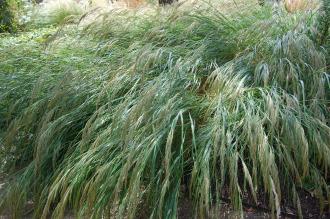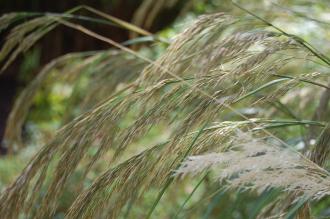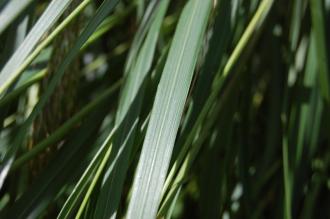
Stipa calamagrostis (18/07/2015, Kew Gardens, London)
Position: Full sun
Flowering period: Summer
Soil: Moist, well drained
Eventual Height: 1m
Eventual Spread: 1.2m
Hardiness: 5a, 5b, 6a, 6b, 7a, 7b, 8a, 8b, 9a
Family: Poaceae
Stipa calamagrostis is a deciduous clump forming, tufted perennial grass. Its grey/ green leaves are strap shaped with entire margins, arching, up to 1m long and 1cm across. Its flowers are borne on arching stems and appear as plumes, these are initially pale green, maturing to light buff. Its seed heads may be retained on the plant during the winter months.

Stipa calamagrostis Flower (18/07/2015, Kew Gardens, London)
Stipa calamagrostis, commonly known as Rough Feather Grass, Pheasant Tail Grass or Pheasant Grass, is native to central and southern Europe. Stipa calamagrostis is synonymous with Achnatherum calamagrostis.
The etymological root of the binomial name Stipa is derived from the Greek meaning ‘fiber’. Calamagrostis is from the Greek Kalamos meaning ‘reed’ and agros meaning ‘field’.
The landscape architect may find Stipa calamagrostis useful as part of a prairie type planting scheme. It looks fantastic when planted en mass. Once established this grass is drought tollerant.

Stipa calamagrostis Leaf (18/07/2015, Kew Gardens, London)
Ecologically, Stipa calamagrostis seed is attractive to some birds and mammals.
Stipa calamagrostis prefers moist, humus rich, well-drained soils. It tolerates most pH of soil.
Stipa calamagrostis requires little maintenance. Old stems may be cut to 15cm above ground level in spring. Large lumps may be divided in mid spring.

Landscape Architecture

